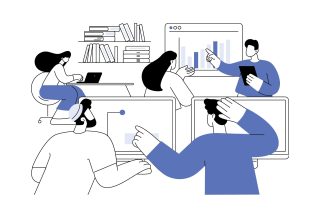FOCUS
Professional learning can unlock technology's potential
By Suzanne Bouffard
Categories: TechnologyApril 2024
With recent leaps in technology, it can seem like new technology tools will either solve all of education’s problems or intensify them. But those kinds of extreme outcomes rarely come to pass, especially in ecosystems as complex as schools. The reality is far more nuanced, and that leaves educators with myriad questions, concerns, and emotions.
This issue of The Learning Professional digs into the interconnected and often contradictory benefits and challenges of technology integration in professional learning. The authors offer both a hopeful perspective and a practical one, highlighting the potential of the latest technology to improve educators’ and students’ learning while also acknowledging struggles and explaining how they are overcoming them.
At the heart of this issue is the recognition that meaningful professional learning about technology goes far beyond a workshop on how to log in to and manage the latest software. That kind of training can be a helpful starting point but, by itself, will not lead to better instruction and higher student achievement.
As the recently released National Educational Technology Plan explains, the digital divide among more and less advantaged schools and students is not just about internet connectivity and device availability. It is also about inequities in educators’ capacity to use technology in active, critical thinking tasks that lead to better student outcomes, rather than passive assignment completion that may simplify logistics but doesn’t benefit students. As Zac Chase, one of the plan’s authors, explains in this issue, those inequities are tied to inequitable access to professional learning time, resources, and support.
Learning professionals must address that inequity. As Liz Kolb and colleagues show, many educators, including early career teachers, are underprepared to use today’s technology, and as the At a Glance infographic illustrates (p. 81), educators have a wide range of questions and topics they want to learn more about.
Fortunately, many educators and organizations are rising to the challenge and facilitating learning about technology integration. For example, authors in this issue show how technology coaching can help teachers overcome their resistance and get the knowledge and skills they need and students deserve. Sustained, in-depth learning about technology integration that goes beyond large-scale workshops is making a difference for teaching and learning, as in a recent effort in Denver Public Schools in Colorado.
One of the biggest technology topics on educators’ minds is artificial intelligence. As generative AI evolves rapidly, its implications for professional learning, and for education in general, are just beginning to emerge. We turned to Justin Reich, of the Teaching Systems Lab at MIT, for insights and advice on whether, when, and how to incorporate AI into professional learning. In his Q&A, his first recommendation is to start by understanding how the technology works. That is also an overarching theme of this issue: developing understanding — and building support for others to develop understanding — is the first step to ensuring technology is not just a gizmo or a gimmick and is more than a nice-to-have.
We hope this issue deepens your understanding, inspires your practice, and informs your leadership. Just as technology has an increasing presence in schools, it will continue to be an important topic of professional learning and this publication. As you navigate the rapidly evolving technology landscape, share with us your questions, concerns, hopes, and successes, and we’ll all keep learning together. As Reich reminds us, “The best professional learning happens when educators come together … (and) that doesn’t come from plugging a prompt into any technology tool.”
Justin Reich of MIT reminds us, “The best professional learning happens when educators come together … (and) that doesn’t come from plugging a prompt into any technology tool.” #EdTech #TheLearningPro Share on X
… (and) that doesn’t come from plugging a prompt into any technology tool.” #EdTech #TheLearningPro Share on X
Download the PDF here.

Suzanne Bouffard is senior vice president of communications and publications at Learning Forward. She is the editor of The Learning Professional, Learning Forward’s flagship publication. She also contributes to the Learning Forward blog and webinars. With a background in child development, she has a passion for making research and best practices accessible to educators, policymakers, and families. She has written for many national publications including The New York Times and the Atlantic, and previously worked as a writer and researcher at the Harvard Graduate School of Education. She has a Ph.D. in developmental psychology from Duke University and a B.A. from Wesleyan University. She loves working with authors to help them develop their ideas and voices for publication.
Categories: Technology
Recent Issues
LEARNING DESIGNS
February 2025
How we learn influences what we learn. This issue shares essential...
BUILDING BRIDGES
December 2024
Students benefit when educators bridge the continuum of professional...
CURRICULUM-BASED PROFESSIONAL LEARNING
October 2024
High-quality curriculum requires skilled educators to put it into...
LEARNING TO PIVOT
August 2024
Sometimes new information and situations call for major change. This issue...












